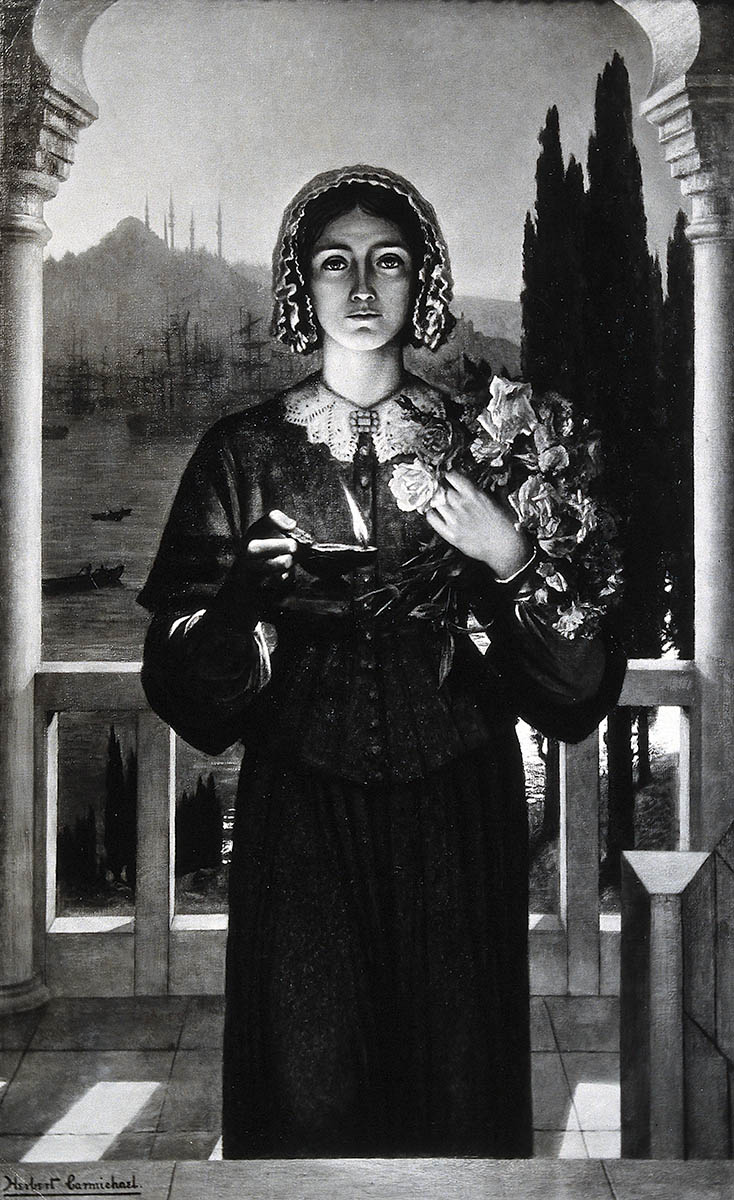The rise of photography sparked debates about authenticity and the role of the artist. Unlike painting, which involved subjective interpretation, photography was seen as a mechanical process that could capture reality without bias. This distinction led to a reevaluation of what constituted true artistic skill and creativity.

V0028761 Florence Nightingale. Photograph after a painting by Herbert
Credit: Wellcome Library, London. Wellcome Images
images@wellcome.ac.uk
http://wellcomeimages.org
Florence Nightingale. Photograph after a painting by Herbert Carmichael.
Published: -Copyrighted work available under Creative Commons Attribution only licence CC BY 4.0 http://creativecommons.org/licenses/by/4.0/
Impact on Portraiture
Before photography, portraits were a primary genre in painting, often reserved for the wealthy due to the time and cost involved. Photography democratized portraiture, allowing people of all social classes to have their likeness captured. This forced painters to innovate and find new ways to add value to painted portraits, often focusing on capturing psychological depth and character that went beyond mere physical resemblance.
Encouraging New Artistic Techniques and Styles
Influence on Light and Shadow
The precise manner in which photography captured light and shadow influenced painters to study these elements more meticulously. The exploration of chiaroscuro (the treatment of light and shadow) became more pronounced, as artists aimed to replicate the photographic effects of natural lighting.
Innovative Use of Color
The limitations of early black-and-white photography made painters more conscious of their unique ability to use color expressively. This led to bold experimentation with color palettes, seen prominently in the works of the Impressionists and Post-Impressionists like Vincent van Gogh, Paul Cézanne, and Georges Seurat.
Introduction of New Compositional Techniques
Photographers often captured candid moments and spontaneous scenes, unlike the posed and staged compositions typical in traditional painting. This approach inspired painters to adopt more dynamic and informal compositions, breaking away from rigid academic conventions.
Realism and Naturalism
As photography captured scenes with objective precision, the Realism movement sought to depict subjects without idealization. Artists like Jean-François Millet and Édouard Manet focused on ordinary people and everyday life, presenting their subjects with a straightforward, unembellished approach.
Impressionism
The Impressionists were significantly influenced by photography’s ability to capture fleeting moments. They sought to portray the effects of light and atmosphere through quick brushstrokes and vibrant colors, often painting en plein air (outdoors) to capture the transient nature of their subjects. This is evident in Claude Monet’s series of paintings like “Haystacks” and “Water Lilies,” which explore light changes over different times of the day and seasons.
Post-Impressionism and Symbolism
Post-Impressionist artists, including Paul Gauguin and Henri Toulouse-Lautrec, moved beyond Impressionism’s focus on light and color to explore more symbolic and emotional content. They used bold colors and exaggerated forms to convey deeper meanings and personal emotions, something that photography’s objective realism couldn’t achieve.
Pictorialism
In response to painting, some photographers in the late nineteenth century embraced Pictorialism, a movement that aimed to make photographs look more like paintings. They used soft focus, manipulated negatives, and other techniques to create images with painterly qualities, emphasizing beauty, tonality, and composition over pure documentation.
Fostering New Concepts of Art
Art as Conceptual
The advent of photography allowed painters to explore more abstract and conceptual ideas, paving the way for movements like Symbolism and later, Abstract Expressionism. Photography freed painters from the burden of representation, allowing them to delve into more innovative and experimental artistic expressions.
Shifts in Artistic Perception
Photography’s mechanical reproduction capability led artists like Walter Benjamin to discuss the “aura” of art— the unique presence that original artworks possess. This dialogue influenced how artists and viewers perceived originality and authenticity in art, contributing to the rise of modernist thinking.
Documentation and Reference
Many painters used photographs as references for their work. For instance, Eugène Delacroix and Thomas Eakins utilized photographs to study anatomy and movement more precisely. This practical use of photography allowed painters to focus on compositional and thematic experimentation.
Conclusion
Photography’s emergence in the nineteenth century profoundly transformed painting, instigating a shift from traditional realism to innovative artistic expressions. By challenging painters to rethink their techniques and subjects, photography catalyzed the development of new artistic movements and concepts. It expanded the boundaries of visual art, allowing painters to explore light, color, composition, and abstraction in unprecedented ways. The dynamic interplay between photography and painting not only enriched both mediums but also laid the groundwork for the diverse art forms we celebrate today.
